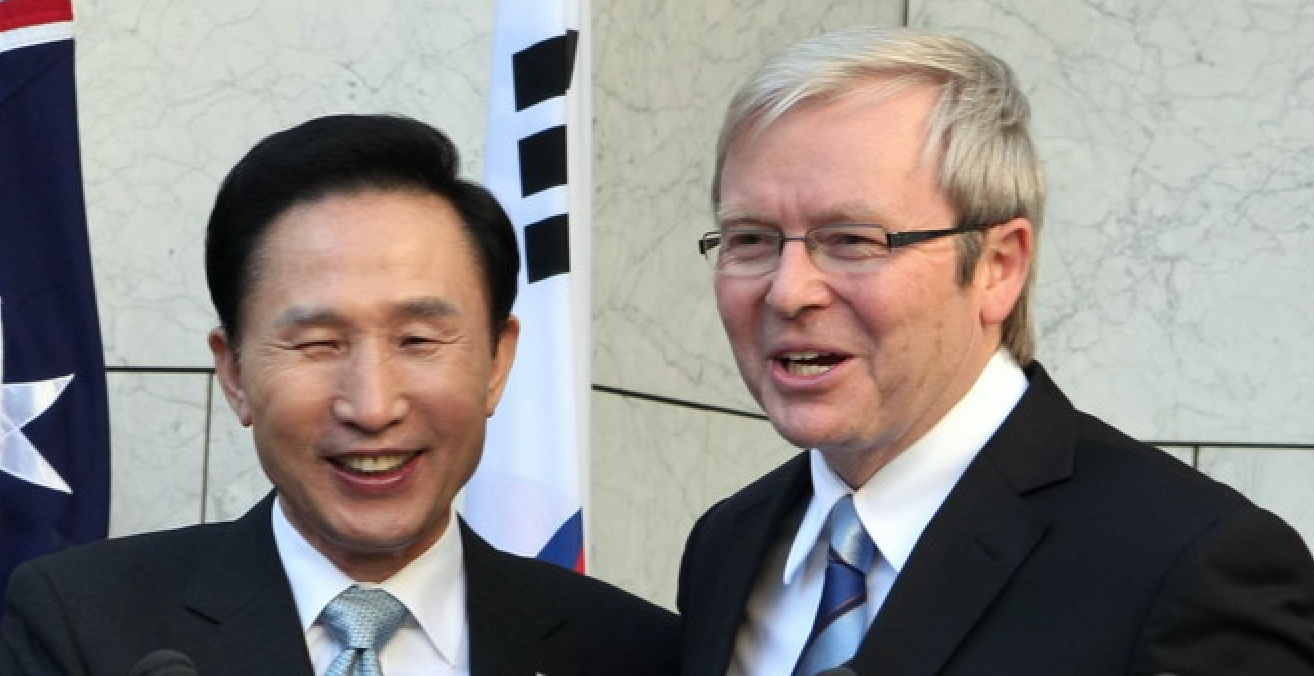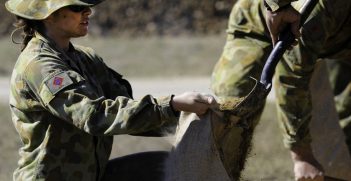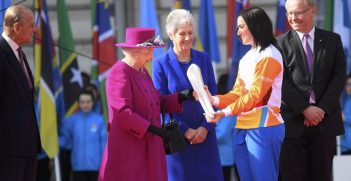Australia and South Korea Middle Power Security Cooperation

The Australia-South Korea relationship is a particularly representative example of a middle power security dyad, where inter-personal leadership dynamics were crucial in bringing about a closer strategic partnership.
On 5 March 2009, Australian Prime Minister Kevin Rudd and South Korean President Lee Myunbak signed the “Joint Statement on Enhanced Global and Security Cooperation between Australia and the Republic of Korea” — hereafter referred to as “Joint Statement” — in Canberra, Australia. The Joint Statement outlined an ambitious nine-point “Action Plan” for upgrading the bilateral strategic partnership across a range of political, military, and security activities. While Australia and South Korea had enjoyed longstanding, if quite modest, security relations since the end of the Cold War, the Action Plan identified over 40 specific activities for cooperation between 14 Australian and 12 Korean government agencies covering law enforcement, border security, countering terrorism and weapons of mass destruction, peacekeeping, defence industry, maritime security and development assistance. As South Korea’s first such security agreement apart from the United States, the 2009 Joint Statement was a major milestone in the bilateral relationship and has been described by some as a “virtual security alliance.”
The Australia-South Korea relationship is a particularly useful and representative example of a middle power security dyad. Unlike security cooperation between middle powers and major powers such as India or Japan, with whom there might be larger cooperation payoffs, cooperation between middle powers themselves is usually a costly exercise given the capability constraints that are central to middle power theorising. In this regard, the Australia-South Korea relationship represents one of the most likely cases in which to expect middle power security cooperation given they are significant military powers compared to other middle powers such as Indonesia, Malaysia, or Vietnam. Moreover, they enjoy strong complementarity of capabilities and interests as formal treaty allies of the United States, liberal democracies, advanced economies with robust trading ties, and no history of adversarial relations between them.
While not discounting the role of structural factors as necessary conditions for middle power security cooperation, the rise of China and US pressure are weak at explaining middle power strategic choices in horizontal contexts towards each other, as opposed to vertical security cooperation with great powers. This is because the identification and engagement of particular cooperation partners in horizontal contexts is usually an optional choice. In the case of the Joint Statement, the article finds that the decision to upgrade security cooperation in 2009 was, in fact, due to a congruence in the leadership preferences of Prime Minister Kevin Rudd of Australia and President Lee Myung-bak of South Korea, without which cooperation was unlikely. The article argues that the literature’s preference for structural explanations has led it to overlook the importance of domestic factors which filter existing structural incentives into actual policy cooperation. In doing so, it questions assumptions in the international relations and security studies literature regarding how middle powers behave during periods of great power rivalry and transition.
To date, much of the existing research on middle powers has focused on how they play coalition-building roles in multilateral or minilateral settings. This article examines whether the same assumptions also hold true in bilateral settings. It also focuses specifically on how conventional security cooperation occurs rather than cooperation on global governance or transnational issues which have dominated the middle power literature. Second, it opens up the research agenda from the current preoccupation with vertical security relations between middle powers and great powers by looking at horizontal security cooperation among middle powers themselves. While comparative security studies of how middle powers deal with the United States or China have grown increasingly popular over the past decade, relatively little attention has been paid to the horizontal interactions that occur between middle powers on security issues. Horizontal security cooperation in the Asia-Pacific has received growing attention as a strategic choice for middle powers to respond to US–China competition, and this article presents a case study focusing exclusively on how these types of relationships might operate.
In the case of middle powers, the decision to initiate or upgrade security ties with specific partners in horizontal contexts ultimately rests with the policymakers of individual countries. This is because horizontal security cooperation is, in most cases, a choice rather than a strategic necessity. The transaction payoffs from horizontal security cooperation are always lower than for vertical cooperation with major or great powers, where threats to national survival are often high and there are asymmetric rewards for engagement. For middle powers such as Australia and South Korea, deciding who to cooperate with on security and defence issues beyond the United States depends heavily on leaders’ preferences. Expanding on past work on the concept of “niche diplomacy,” for middle powers, it is leaders who need to approve the use of limited political-diplomatic capital in choosing which countries they would like to upgrade ties with. Leaders have fewer incentives to commit to or initiate security cooperation with partners who do not share their specific strategic outlook or interests.
For both Rudd and Lee, their belief that their respective countries had a significant leadership role to play was framed in specific ways. For Rudd, this channeled the internationalist tradition of previous Labor governments in playing an influential and proactive regional role. For Lee, this was driven by the dual demands of strengthening South Korea’s alliance with the United States but also of a decidedly economic-oriented approach to foreign policy. As the following discussion demonstrates, for Rudd and Lee, the perception of each other as important strategic partners evolved through the course of their personal interactions, with security cooperation constituting only one component of their desire to upgrade the overall relationship. The following section traces their personal relationship in the lead-up to the 2009 Joint Statement to demonstrate this claim.
The 2009 Joint Statement suggests that inter-personal leadership dynamics were crucial in bringing Australia and South Korea towards a closer strategic partnership. The personal partnership between Rudd and Lee—who both came to office with complementary, though distinct, strategic visions of their countries as playing a regional leadership role—was highly conducive to these two leaders working together during a period of major economic crisis. An important counterfactual question for this article is whether Australia-Korea security cooperation would have been more or less likely had the changes in government not occurred in Australia in December 2007 and in Korea in February 2008. A review of the main policy pledges of Roh Moo-hyun’s designated successor, Chung Dong-young, in the 2007 presidential election as well as John Howard’s 2007 election platform suggests that, had either individual been elected, there would have been significant continuity in each sides’ strategic focus, suggesting a higher likelihood of different partner selection.
Greater attention should be paid to examining which leadership partnerships exhibit higher degrees of congruence or dissonance in terms of strategic outlook. One such approach that has recently received considerable attention among middle power scholars has been to focus on how self-identification and the perceptions that policymakers hold might affect state behaviour. For example, recent research using comparative case studies of Asia-Pacific middle powers such as Australia, South Korea, and Indonesia has demonstrated significant differences in how policymakers interpret and enact distinct national roles for their country which can, in turn, usefully explain behavioural variations over time. But whereas the existing research on how middle power identity has looked at how states interpret their position and status in the international system, this article suggests that individual-level variation among leaders can be just as significant in explaining inter-state partnerships in the middle power context.
Peter K. Lee is a PhD candidate in the Strategic and Defence Studies Centre, Coral Bell School of Asia Pacific Affairs, College of Asia and the Pacific, at the Australian National University.
This article is an extract from Lee’s article in the Australian Journal of International Affairs titled “Middle power strategic choices and horizontal security cooperation: the 2009 Australia-South Korea security cooperation agreement.” It is republished with permission.





